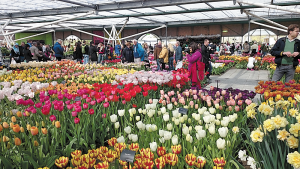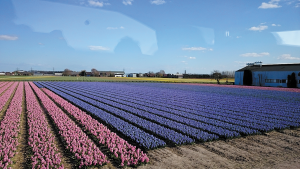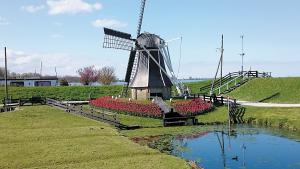May 28, 2015
Everything Dutch
Amsterdam brings to mind many different images for those who have never visited. I envisioned the idyllic world of tulips, wooden shoes, and windmills. It was that and much, much more that I saw on our recent river boat cruise from Holland to Belgium. What I didn’t know is that Amsterdam, built in the 12th century around a dam on the Amstel River, is today the seat of one of the world’s chief stock exchanges, a center of the diamond-cutting industry, and one of the great commercial, intellectual, and artistic capitals of Europe.
One of the most important physical features of Amsterdam is its network of canals. It grew up around 40 concentric and radial canals, bordered by streets and crossed by over 400 bridges. During the early part of the 1600s, Amsterdam was in the throes of its Golden Age, and the town was expanding faster than it could keep up. New houses, constructed along the canals, became homes to the emerging merchants, artist and political class. Due to inherent restrictions on space and the policy of taxing houses on the frontage width, homes were built tall and skinny with long sleek windows and soaring gables. The buildings often served as both homes and workplace. A unique feature was the hook affixed to the top of the narrow houses used to hoist furniture and goods up and through the windows. This tradition is still observed today, as we witnessed when we stopped to watch a couch being hoisted to the top and through an apartment window.
Today, Amsterdam has 165 canals with over 1500 bridges. Sixteen hundred buildings have protected heritage status. What makes the area unique is not just the beautiful architecture and canals, but the tiny alleys, gardens and stories hidden behind the historic facades of the houses. The narrow streets somewhat restrict the use of automobiles making walking or bicycling the preferred method of transportation whenever possible.
 Our walking tour of the city took us past the flower markets, quaint outdoor cafes, and through the iconic ‘Red Light District’ which has in recent years ‘cleaned up its act’ so to speak. With a 2 ½ hour wait to see the Anne Frank House, we opted to take pictures of the exterior and continue our stroll down the canal. We avoided the coffee shops with their legendary ‘brownies,’ choosing instead to quench our thirst with a cold Dutch brew and an order of “not so French” fries!
Our walking tour of the city took us past the flower markets, quaint outdoor cafes, and through the iconic ‘Red Light District’ which has in recent years ‘cleaned up its act’ so to speak. With a 2 ½ hour wait to see the Anne Frank House, we opted to take pictures of the exterior and continue our stroll down the canal. We avoided the coffee shops with their legendary ‘brownies,’ choosing instead to quench our thirst with a cold Dutch brew and an order of “not so French” fries!
Within the walls of the century old churches and massive stone museums are stories of the history and culture of the Dutch people. Few other countries can boast having fathered so many great artists; it is believed that during the Golden Age of the 17th century an estimated 20 million paintings were executed. Our visit to the Rijksmuseum was just a tiny sampling of the works of the many Dutch masters.
With ‘history overload’ and tired feet, we headed to the Waterfront, the original source of the city’s wealth and cultural history. It is here that we found the MS Treasures Riverboat, our ‘home away from home’ for the next few days. After settling in our cabin, and dining with our fellow travelers we settled in for a restful first night on the riverboat.
 Our next day’s journey took us through the countryside to Lisse, just South of Amsterdam. The landscape, dotted with singular farmsteads and grazing animals, could have been a scene from Iowa or Illinois. As a matter of fact the Netherlands is one of the world’s largest agricultural producers, exporting $75 billion worth of vegetables, fruit, flowers, meat and dairy products each year. A closer look at the barns’ thatched roofs and the vibrant pinks, deep purples, and brilliant yellow rows of flowers in the fields set these rural homesteads apart from our Midwest farms. The Netherlands is famous for its bulbs grown for export, with nearly 60,000 acres planted in tulips, hyacinths, daffodils, narcissus, and crocus. Our visit to Keukenhof Gardens was the highlight of my trip. Never before have I seen so many beautiful flowers blooming in one place. Over one hundred varieties of 6 million tulips, daffodils and hyacinths blooming on nearly 80 acres certainly raised the bar for my gardening efforts back home.
Our next day’s journey took us through the countryside to Lisse, just South of Amsterdam. The landscape, dotted with singular farmsteads and grazing animals, could have been a scene from Iowa or Illinois. As a matter of fact the Netherlands is one of the world’s largest agricultural producers, exporting $75 billion worth of vegetables, fruit, flowers, meat and dairy products each year. A closer look at the barns’ thatched roofs and the vibrant pinks, deep purples, and brilliant yellow rows of flowers in the fields set these rural homesteads apart from our Midwest farms. The Netherlands is famous for its bulbs grown for export, with nearly 60,000 acres planted in tulips, hyacinths, daffodils, narcissus, and crocus. Our visit to Keukenhof Gardens was the highlight of my trip. Never before have I seen so many beautiful flowers blooming in one place. Over one hundred varieties of 6 million tulips, daffodils and hyacinths blooming on nearly 80 acres certainly raised the bar for my gardening efforts back home.
Windmills are an iconic part of the Dutch landscape and our visit to one was a must. More than 10,000 windmills once dotted the Dutch landscape, but today only 1000 remain. They were an integral part of Dutch life for centuries, employed for industrial purposes like milling grains or draining the lowlands of excess water.
 Each of the villages in Holland have distinctive features and unique contributions they have made to the history and heritage of the Dutch people. Hoorn, founded in 1300 on the shores of a natural haven, was where the first herring net was made, marking the beginning of what was to become a flourishing industry. Enkhuizen was the main Friesian settlement and the seat of the Friesian chiefs until 1289. In the 18th century at its highest point it was a whale-fishing town totaling 50,000 people. Zeeland which literally means “sea-land,” has been forever plagued with flooding. Today it is the home of many huge wind turbines, a significant source of energy for the area. Throughout the Netherlands, 1,879 onshore wind turbines have been installed constituting about 10 percent of the Netherlands’ energy. Middleburg is the capital of Zeeland, once was a fortress city surrounded by defensive walls that protected the inhabitants from the Viking invaders. Veer, a delightful town full of lovely boutiques, was once a powerful trading center and a one of the main ports for shipments from Scotland and Britain. Today, vestiges of this connection are found in fine woolen items and a penchant for Scotch Whiskey. Delft, with its tidy doorsteps, winding canals and beautiful 17th century merchant houses, has all the hallmarks of a traditional Dutch village. During the 17th century it experienced unprecedented wealth and prosperity. It is the home of the famous Dutch “Delftware” which is in plentiful supply in the many shops throughout the town. The famous painter Johannes Vermeer hailed from Delft.
Each of the villages in Holland have distinctive features and unique contributions they have made to the history and heritage of the Dutch people. Hoorn, founded in 1300 on the shores of a natural haven, was where the first herring net was made, marking the beginning of what was to become a flourishing industry. Enkhuizen was the main Friesian settlement and the seat of the Friesian chiefs until 1289. In the 18th century at its highest point it was a whale-fishing town totaling 50,000 people. Zeeland which literally means “sea-land,” has been forever plagued with flooding. Today it is the home of many huge wind turbines, a significant source of energy for the area. Throughout the Netherlands, 1,879 onshore wind turbines have been installed constituting about 10 percent of the Netherlands’ energy. Middleburg is the capital of Zeeland, once was a fortress city surrounded by defensive walls that protected the inhabitants from the Viking invaders. Veer, a delightful town full of lovely boutiques, was once a powerful trading center and a one of the main ports for shipments from Scotland and Britain. Today, vestiges of this connection are found in fine woolen items and a penchant for Scotch Whiskey. Delft, with its tidy doorsteps, winding canals and beautiful 17th century merchant houses, has all the hallmarks of a traditional Dutch village. During the 17th century it experienced unprecedented wealth and prosperity. It is the home of the famous Dutch “Delftware” which is in plentiful supply in the many shops throughout the town. The famous painter Johannes Vermeer hailed from Delft.
Amid today’s peacefulness in these charming towns scattered throughout the Netherlands and Belgium is another story of the death and destruction in World War II. Stay tuned in July for the “rest of the story”?
Mary, a former educator and Seniors Real Estate Specialist, is the author of two books, The West End Kid and Labor of Love; My Personal Journey through the World of Caregiving (available at www.amazon.com)



